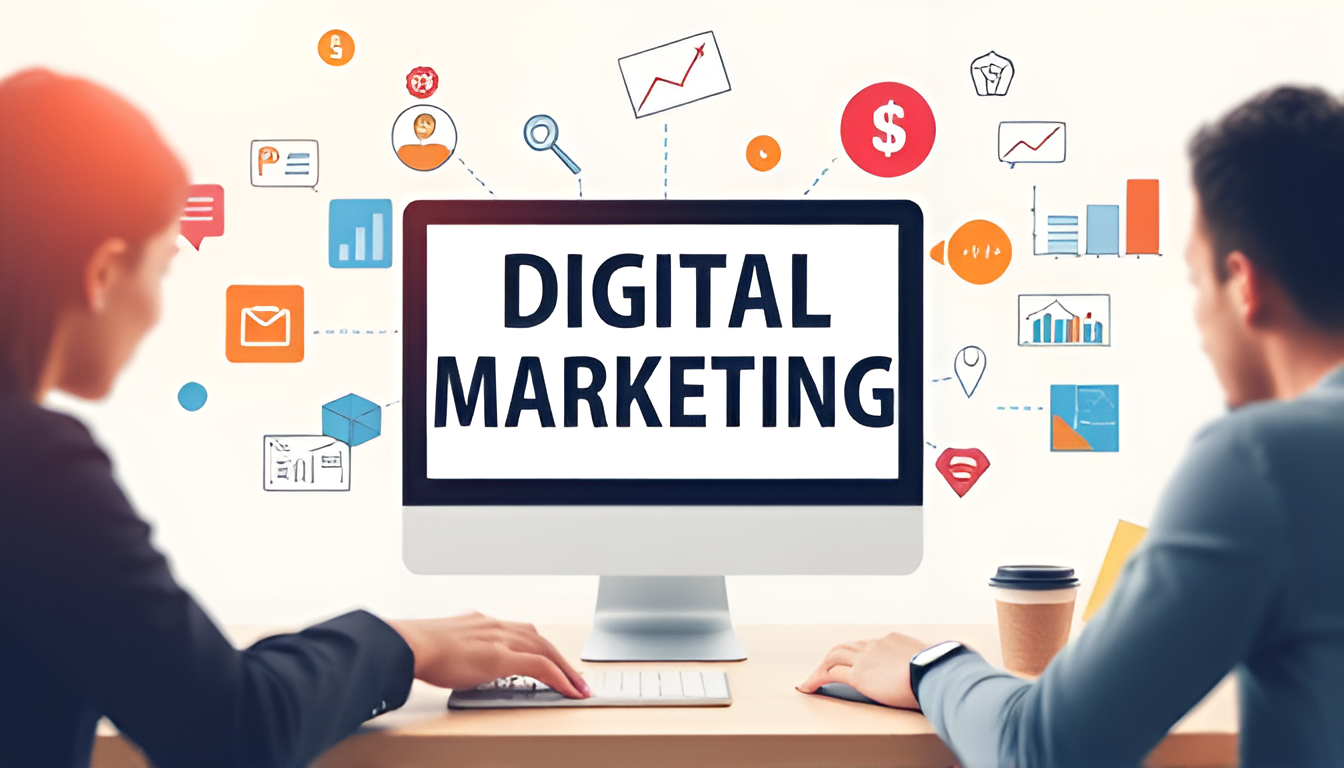Digital marketing has become an essential component of business success in today’s hyper-connected world. As consumers increasingly spend time online, businesses are compelled to meet them where they are. Whether you’re a small business owner, marketer, or entrepreneur, understanding digital marketing can significantly boost your brand’s visibility and help you reach your target audience more effectively.
In this comprehensive guide, we will explore everything you need to know about digital marketing, including its different components, strategies, tools, and best practices. By the end, you’ll have a clear understanding of how to leverage digital marketing to grow your business.
1. What is Digital Marketing?
Digital marketing refers to all marketing activities that use the internet or an electronic device. It includes any online marketing efforts or assets such as search engines, websites, social media, email, and online advertising. Businesses use digital channels to connect with current and prospective customers.
Unlike traditional marketing, digital marketing allows businesses to track and measure the effectiveness of their efforts in real time, giving them the flexibility to adjust their strategies and reach their audience more effectively.
2. Why is Digital Marketing Important?
Digital marketing offers several key advantages over traditional marketing methods:
- Global Reach: Digital marketing allows businesses to reach a global audience with relatively minimal effort and expense. A website can attract visitors from all over the world, expanding the potential customer base.
- Cost-Effective: Compared to traditional marketing methods, digital marketing often costs less while offering greater control over the budget. For example, paid search and social media advertising allow you to set budgets according to your needs.
- Measurable Results: With digital marketing, every click, impression, and conversion is trackable. Tools like Google Analytics and social media insights provide real-time data on how campaigns are performing, enabling better optimization.
- Targeted Audience: Digital marketing allows businesses to narrow down their audience and target ads to people based on demographics, interests, and behaviors. This enhances the chances of reaching the right customers.
- Increased Engagement: Through digital marketing, brands can engage with customers on a more personal level. Social media, for example, allows for direct interaction through comments, likes, and shares, fostering brand loyalty.
3. Core Components of Digital Marketing
3.1 Search Engine Optimization (SEO)
SEO refers to the process of optimizing your website to rank higher in search engine results pages (SERPs). The higher your site ranks for relevant keywords, the more visibility it gets, leading to increased organic traffic. SEO can be broken down into two primary components:
- On-Page SEO: Involves optimizing the content on your website, such as using keywords, meta tags, and structured data to ensure search engines can easily crawl and index your site.
- Off-Page SEO: Focuses on building external links, or backlinks, to your site from other reputable websites, enhancing your domain authority.
SEO is a long-term strategy, but when done right, it generates highly qualified leads.
3.2 Content Marketing
Content marketing is all about creating and sharing valuable, relevant content to attract and retain a target audience. The goal is to provide valuable information to potential customers, thus fostering trust and positioning your brand as an authority in your niche.
Content marketing includes:
- Blogs: Regularly updated articles that provide insights and information related to your industry.
- Videos: Engaging content that can be shared across social media or used for tutorials, product launches, etc.
- Infographics: Visual representations of data or ideas that are easily shareable.
- E-books/Whitepapers: Long-form content used to demonstrate expertise and capture leads.
3.3 Social Media Marketing (SMM)
Social media marketing uses platforms like Facebook, Instagram, LinkedIn, Twitter, and TikTok to promote products or services. It involves both organic and paid tactics, enabling businesses to reach a vast audience.
Key elements of social media marketing include:
- Creating Engaging Content: Posts, stories, and reels tailored to each platform’s audience.
- Influencer Marketing: Partnering with individuals who have a strong following in your niche.
- Paid Advertising: Using paid promotions like Facebook Ads or Instagram Ads to target specific demographics.
3.4 Pay-Per-Click Advertising (PPC)
PPC advertising allows businesses to display ads on search engines, websites, or social media platforms, and only pay when someone clicks on the ad. The most popular form of PPC is Google Ads, where businesses bid on keywords, and their ads appear in the search results.
PPC campaigns can be highly effective because they offer instant visibility and results. However, careful planning and constant optimization are required to manage costs and achieve a high return on investment (ROI).
3.5 Email Marketing
Email marketing remains one of the most cost-effective digital marketing channels. It involves sending newsletters, promotional offers, and product updates directly to a list of subscribers. The key to successful email marketing is personalization and segmentation, ensuring that the right message reaches the right audience.
Some common email marketing tactics include:
- Welcome Emails: Sent to new subscribers to introduce your brand.
- Drip Campaigns: A series of automated emails sent over a period, often used to nurture leads.
- Promotional Emails: Emails designed to promote products, services, or sales events.
3.6 Affiliate Marketing
Affiliate marketing is a performance-based strategy where businesses reward affiliates (other websites, influencers, or individuals) for driving traffic or sales to their site. This method is particularly useful for e-commerce businesses.
Affiliates promote a company’s product or services through their own marketing channels (websites, social media, email lists) and earn a commission for each conversion or sale.
3.7 Influencer Marketing
Influencer marketing leverages the power of individuals with large, engaged followings on social media platforms. Businesses partner with influencers to promote their products or services through content like sponsored posts, stories, or reviews. Influencer marketing helps build trust and credibility quickly since followers often regard the influencer’s recommendations as authentic.
4. Key Digital Marketing Strategies
4.1 Personalization
Personalization involves tailoring marketing messages to individual users based on their behavior, preferences, and demographics. Businesses use data analytics to create more relevant content, offers, and ads, boosting engagement and conversion rates. Personalization can be as simple as including a subscriber’s name in an email or as complex as creating entire marketing funnels based on user behavior.
4.2 Omnichannel Marketing
Omnichannel marketing provides a seamless experience for customers across all digital channels, whether it’s social media, email, or a website. The goal is to create a consistent brand experience, regardless of the platform the customer is interacting with. This improves customer retention and builds stronger relationships.
4.3 Data-Driven Marketing
With the rise of big data, businesses now have access to massive amounts of consumer data. Data-driven marketing involves using this information to make informed decisions about campaigns, from which channels to invest in, to which audience segments to target.
4.4 User-Generated Content (UGC)
UGC involves leveraging content created by users, such as reviews, photos, and social media posts. UGC can act as powerful social proof, influencing potential customers to trust and engage with your brand. Encouraging users to share their experiences can organically extend your marketing reach.
5. Popular Digital Marketing Tools
A wide range of tools exists to help marketers streamline their campaigns, analyze performance, and optimize their strategies. Here are some of the most popular tools:
- Google Analytics: A free tool that tracks website traffic, user behavior, and conversion data.
- SEMrush: A comprehensive SEO tool that allows businesses to track keyword rankings, competitor strategies, and conduct site audits.
- Mailchimp: An email marketing tool that helps businesses create, send, and track email campaigns.
- Hootsuite: A social media management platform that allows businesses to schedule posts, track performance, and engage with followers across multiple platforms.
- Google Ads: A paid advertising platform where businesses can bid on keywords to display ads in search engine results.
- Canva: A design tool that allows businesses to create visually appealing graphics for social media, blogs, and websites.
6. The Future of Digital Marketing
As technology evolves, so too does digital marketing. Some trends that are likely to shape the future of digital marketing include:
- Artificial Intelligence (AI): AI is increasingly being used in digital marketing for data analysis, personalization, and even content creation. Chatbots and machine learning algorithms are helping brands improve customer service and streamline marketing efforts.
- Voice Search Optimization: With the growing popularity of voice assistants like Siri, Alexa, and Google Assistant, optimizing for voice search is becoming essential. Brands will need to create content that answers common voice search queries in a conversational manner.
- Video Marketing: Video is already a major component of digital marketing, and its popularity is expected to grow. Platforms like YouTube, TikTok, and Instagram are making it easier for brands to share engaging video content with their audiences.
- Interactive Content: Interactive content, such as polls, quizzes, and augmented reality (AR) experiences, is gaining traction. This content type increases engagement and allows brands to gather valuable data on their audience.
- Sustainability and Social Responsibility: Consumers are becoming more concerned with the ethical practices of the brands they support. Digital marketing strategies that emphasize sustainability and social responsibility will resonate more with modern audiences.
7. Conclusion about Digital Marketing
Digital marketing is a dynamic, ever-evolving field that offers businesses incredible opportunities to reach and engage their target audience. By understanding its core components and staying ahead of emerging trends, businesses can create effective marketing strategies that drive growth and success.
Whether you’re looking to boost brand awareness, increase website traffic, or convert leads into customers, digital marketing provides the tools and platforms to achieve these goals efficiently.

